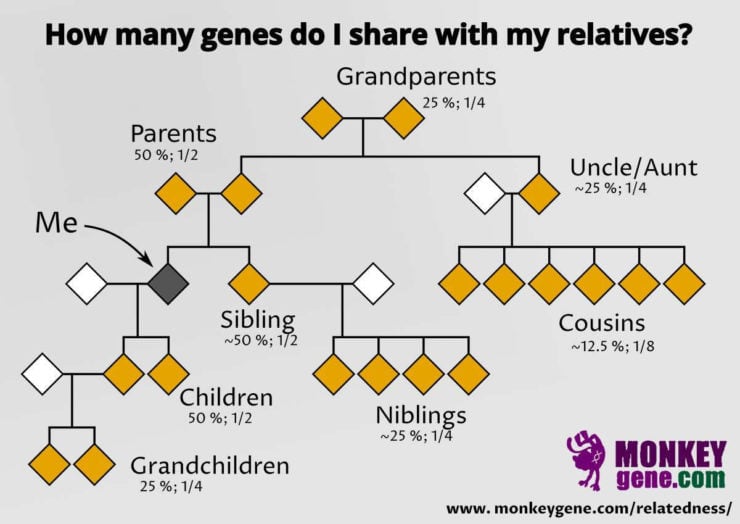It’s easy to calculate how many genes you share with your parents, children, siblings, and other relatives. Given the fact that parents pass half of their genes to their children, and siblings share half of their genes, the rest is just math. To determine this, you just have to divide genetic relatedness each time you go up or down a step in a family tree, or sideways.
For example, you can find a cousin by going one step up to your parent, one step sideways to your parent’s sibling, and then one step down to your cousin. These three steps mean you have to divide 100% relatedness in half three times: 100/2=50%, 50/2=25%, and then 25/2=12.5%.
It’s not easy to do these calculations in my head each time I need them; thus, I have created a diagram of family tree relatedness for my reference and posted it below. If you find it useful, too, you’re welcome to it.

Here is a longer list of genetic relatedness among relatives. Remember, this can be applied not only to humans, but also to any diploid, sexually reproducing organism, including all mammals.
- Parents: 50% or 1/2
- Grandparents: 25% or 1/4
- Great-grandparents: 12.5% or 1/8
- Children: 50% or 1/2
- Grandchildren: 25% or 1/4
- Great-grandchildren: 12.5% or 1/8
- For later generations, each is reduced by half again…. 6.25% or 1/16, 3.125% or 1/32, etc…
- Siblings: ~50% or 1/2
- Half-siblings: ~25% or 1/4
- Identical twins: 100% or 1/1
- Fraternal twins: ~50% or 1/2
- Genetically, fraternal twins are like any other siblings, they just the same age.
- Aunts and uncles: ~25% or 1/4
- Nieces and nephews (niblings): ~25% or 1/4
- Cousins: ~12.5% or 1/8
- Second cousins: 3.125% or 1/32
- Third cousins: 0.78125% or 1/128
If you are confused about cousins, your cousin is the child of your parent’s sibling. Your second cousin is a grandchild of your grandparent’s sibling. Meanwhile, your third cousin is a great-grandchild of your great-grandparent’s sibling.
The concept of sharing gene versions with your relatives is important in biology. Thoug natural selection favors the survival of an individual, it is also beneficial to an individual if their relatives also succeed. You can learn more about this here.
Why do siblings share ~50% of their genes?
You may have noticed that, in sibling and cousin relationships, genetic relatedness is noted with ~ signs, which means that the relatedness is approximately 50%. Why is this so?
Genes are instructions to make and run a body, and most of our cells contain two versions of each gene. The exceptions are ova and sperm cells. They have only one, randomly assembled set of genes.
When an ovum and sperm combine, they form a cell with two sets of genes, just like any other type of cell. This new cell will later become a new living being with two sets of genes. One set is from the mother, and the other is from the father. That is why my children have EXACTLY 50% of my gene versions.
However, the reason why siblings share half of their gene versions is different. Each sperm or each ovum is assembled randomly, taking one version (of the two available) of each of the parent’s genes.
According to probability theory, any random sex cell (ovum or sperm) of the same person will share approximately half of the gene versions. Theoretically, it is possible to assemble two identical sperm, yet, practically, this is not likely. In fact, the chance of me winning the lottery, without ever buying a ticket, is magnitudes greater. Most sperm, are actually very, very close to 50% and, mathematically, the probability of being 49% similar or less is slim.
This means that with, significant credibility, we can say that all siblings have a 50% similar genome.